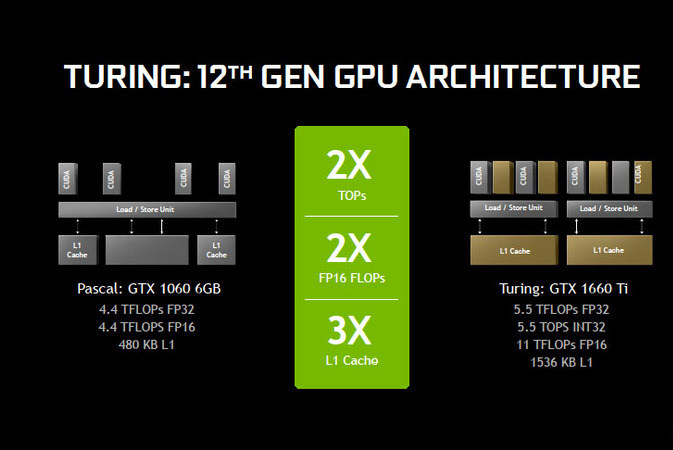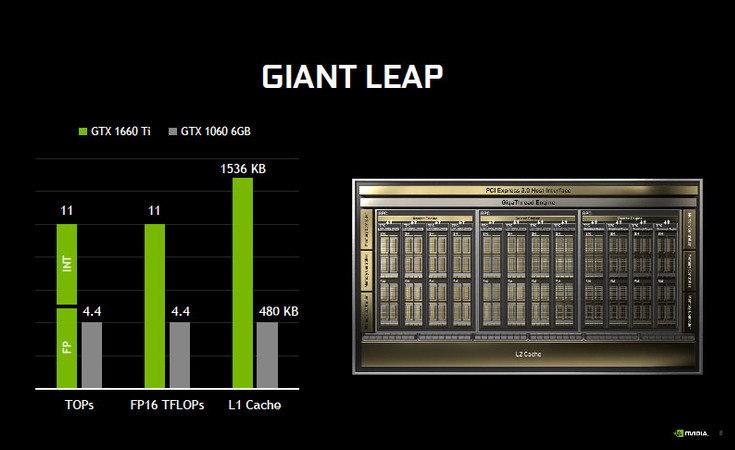
New NVIDIA GeForce GTX 1660 Ti Brings Turing Shaders to the Mainstream Market, Starting at $279
NVIDIA today introduced the GeForce GTX 1660 Ti, a new gaming GPU based on the 12th generation Turing GPU architecture to deliver 2x the TOPS of the previous-generation Pascal architecture.
Available from Nvidia's OEM partners from $279, the GeForce GTX 1660 Ti supports concurrent floating point and integer operations, a unified cache architecture with 3x the L1 cache, and turbocharged performance using adaptive shading technology.

In this sub-$300 Turing card, NVIDIA drops the RT and tensor cores of the RTX series in order to make a more competitive and affordable chip. The card uses the TU116 GPU and it is destined to replace NVIDIA’s GTX 1060 6GB in the market.
The TU116 is a Turing GPU, save the RTX functionality (RT and tensor cores). This means that it has the same core architecture in its SMs, and is directly comparable to the likes of the RTX 2060.


With a die size of 284mm2, the TU116 is 40% smaller than the next-smallest Turing GPU, TU106. Similarly, the transistor count has come down from 10.8 billion to 6.6 billion.
The GeForce GTX 1660 Ti features 1,536 CUDA cores, 6GB of GDDR6 memory running at 12Gbps and a boost clock of almost 1.8 GHz, which can be easily overclocked for further performance.
| GTX 1660 Ti | RTX 2060 Founders Edition | GTX 1060 6GB (GDDR5) | RTX 2070 | |
| CUDA Cores | 1536 | 1920 | 1280 | 2304 |
| ROPs | 48 | 48 | 48 | 64 |
| Core Clock | 1500MHz | 1365MHz | 1506MHz | 1410MHz |
| Boost Clock | 1770MHz | 1680MHz | 1708MHz | 1620MHz FE: 1710MHz |
| Memory Clock | 12Gbps GDDR6 | 14Gbps GDDR6 | 8Gbps GDDR5 | 14Gbps GDDR6 |
| Memory Bus Width | 192-bit | 192-bit | 192-bit | 256-bit |
| VRAM | 6GB | 6GB | 6GB | 8GB |
| Single Precision Perf. | 5.5 TFLOPS | 6.5 TFLOPS | 4.4 TFLOPs | 7.5 TFLOPs FE: 7.9 TFLOPS |
| "RTX-OPS" | N/A | 37T | N/A | 45T |
| SLI Support | No | No | No | No |
| TDP | 120W | 160W | 120W | 175W FE: 185W |
| GPU | TU116 (284 mm2) |
TU106 (445 mm2) |
GP106 (200 mm2) |
TU106 |
| Transistor Count | 6.6B | 10.8B | 4.4B | 10.8B |
| Architecture | Turing | Turing | Pascal | Turing |
| Manufacturing Process | TSMC 12nm "FFN" | TSMC 12nm "FFN" | TSMC 16nm | TSMC 12nm "FFN" |
| Launch Price | $279 | $349 | MSRP: $249 FE: $299 |
MSRP: $499 FE: $599 |
Compared to RTX 2060, the GTX 1660 Ti is actually rather similar. For this fully-enabled TU116 card, NVIDIA has decreased the number of SMs, going from 30 to 24. Memory clockspeeds have dropped as well, from 14Gbps to 12Gbps. But NVIDIA has kept the 6GB of GDDR6 on a 192-bit memory bus. The GTX 1660 Ti has also a slightly higher average boost clockspeed than the RTX 2060, with its 1770Mhz clockspeed giving it a 5% edge here.
In theory, the GTX 1660 Ti has a bit more ROP pixel pushing power than its bigger sibling thanks to that 5% boost clock advantage. However the drop in the SM count hits compute and texture performance, where GTX 1160 Ti is going to deliver around 85% of RTX 2060’s compute and shading throughput. Compared with the GTX 1060 6GB it replaces, on the new card offers around 24% more compute/shader throughput, a much smaller 4% increase in ROP throughput, and a very sizable 50% increase in memory bandwidth.


NVIDIA is going to be holding the line at 120W, which is the same TDP as the GTX 1060 6GB.
The GTX 1660 Ti also includes GeForce Experience, an application that makes PC gaming more accessible and provides easy-to-use in-game features such as:
- NVIDIA Highlights — which automatically captures the best gaming moments. More than 35 games already support Highlights, including Metro Exodus, Fortnite, PLAYERUNKNOWN’S BATTLEGROUNDS, War Thunder, Shadow of Tomb Raider, Ring of Elysium, Escape from Tarkov, Hitman 2, Kingdom Come: Deliverance, Hunt: Showdown, Final Fantasy XV and Tekken 7.
- NVIDIA Ansel — which lets gamers take in-game photos. More than 70 games already support Ansel, including Metro Exodus, Battlefield V, Hitman 2, Shadow of Tomb Raider, For Honor, Star Wars: Battlefront II and Final Fantasy XV. Gamers can share their favorite photos and participate in monthly photo contests on Shot with GeForce.
- NVIDIA Freestyle — which lets gamers customize their games’ appearance with post-processing technology. The latest filters can convert gameplay or photos into an oil painting or a watercolor, or deliver an appearance that is right out of a movie or a retro 1980’s look.
Unlike NVIDIA’s other Turing card launches up until now, the GTX 1660 Ti is not getting a reference card release. Instead all the cards hitting the shelves are customized vendor cards.
As for AMD, the launch of the GTX 1660 Ti essentially puts a Turing card in competition with their Pascal cards, particularly the $279 Radeon RX 590. While AMD hasn’t announced any price changes for the RX 590 at this time, AMD will probably to bring it down in price.
AMD’s competitor for the GTX 1660 Ti looks like it will be the Radeon RX Vega 56. The company plans to lower the promotional prices on the card, including a single model that was available for $279.
With the launch of the GeForce GTX 1660 Ti and the TU116 GPU is not a premium card in terms of price, but it offers a bigger improvement on a price/performance basis than any of the other Turing cards. You can expect a 35% more performance than the GTX 1060 6GB at 1440p / 1080p. And compared to the older Pascal generation 28nm parts, the the GTX 1660 Ti offers well over 2x the performance.





















